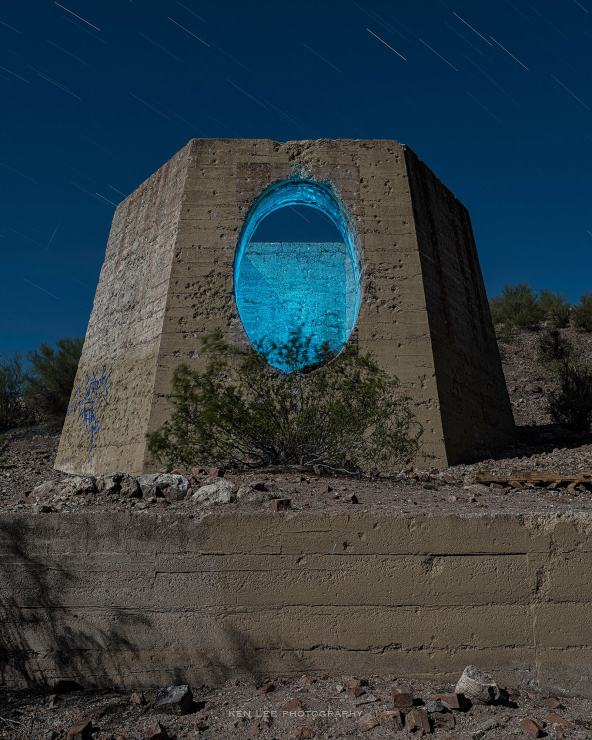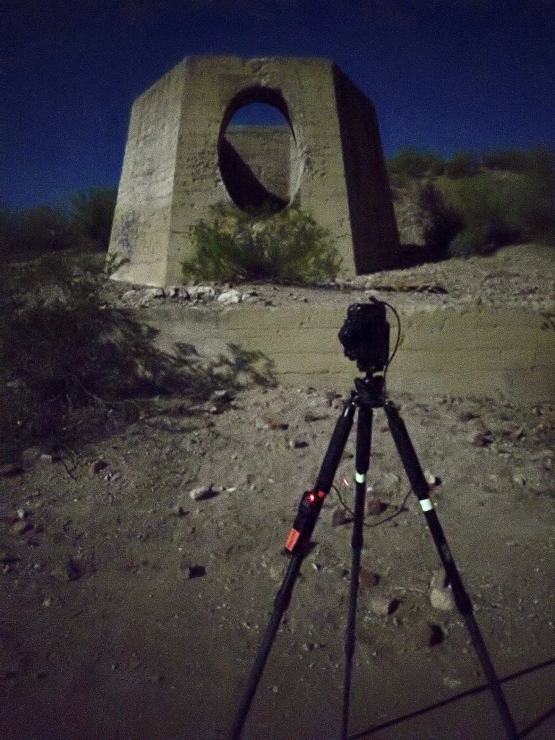We encountered this unusual structure in a ghost town in the Sonoran Desert. Here’s how I got this unusual night photo.

Imagination run amok
During the waning light of the sun, my friend Mike Cooper and I came across this unusual structure. This was a 100-year old smelter. But to me, who watches a lot of “Star Trek,” I instead thought of it as some sort of weird transporter. This is what would inform the way I went about photographing it.
I find that when photographing at night, looking at things as if they were something else often makes for more creative photographs. For example, instead of a wrecked car, I might look at it as a strange space monster. Instead of a tree, it might be a giant human-shaped inflatable wind puppet. This smelter would be an eerily glowing teleportation device.
Setting up the photo

When it grew dark, I placed my Pentax K-1 camera directly in front of the smelter, using a Feisol CT-3342 tripod for stability. I took great care to make sure it was centered. I thought it might look odder and “sci-fi” with a straight, centered photo. Then, I focused on the building itself by shining some light and using autofocus. I use this technique quite a bit for night photography.
Checking out the smelter
The smelter is a very large structure. Someone had placed a wooden pallet in front, presumably to climb in. I climbed up the pallet, considering everything carefully. It was dark. But more than that, my vision was not great, as I was experiencing flashes and floaters as well as increasingly hazy vision. Soon after this trip, I had surgery for a detached retina.
Mike had successfully climbed in and out to illuminate this from the interior. I battled my impulse to also climb inside, deciding not to do it, given my wonky vision.
Lighting the interior
I had to devise another way to make it look like the interior was glowing with eerie energy, ready to “beam” someone to a distant land or spaceship. So, I decided that I would remove the pallet, hop up on one of the stones hidden behind the creosote plant, and wave my ProtoMachines LED2 light painting device back and forth to pick up the texture inside, blocking the light with my body. Then, still blocking the light, I would wave it up and down around the sides of the opening to make it look like the light was emanating from within.
Doing this with numerous colors helped me picture how it looked. I did red, blue, green, and warm white. Ultimately, I decided on a color known among a few of us as Gas Station Teal (™), developed by night photographer Tim Little.
Lighting the exterior
I used a warm white light. Using a 90-degree angle from the structure, I skimmed the light gently on the front to pick up some of the texture. This also made the smelter “pop” a little more compared to the rest of the photo.
Streaks of light
I let the star trails streak across the sky. I did this by taking two-minute exposures and letting the camera run for twelve minutes straight. The star trails would be reasonably long since I was using a Pentax 28-105mm f/3.5-5.6 lens at a focal length of 34mm. After all, the longer the focal length, the more I am zoomed in on everything — including the stars. When I would share the photo later, I would propose that the streaks of light may have been created during the dematerialization process. I did have two people “correct” me, saying that they thought it was star trails. There’s no fooling some people.
Stacking the six photos
I took the six photos and “stacked” them in Adobe Photoshop, changing the blending mode to “lighten”. This allows the lighter parts, including the light painting and star trails, to shine through all together as if it had been a single photo with a twelve-minute exposure. You can also “stack” photos in this manner using StarStax, a free program for Mac, PC, and Linux.
Tell your story with the second annual Visual Storytelling Conference!
Experience four days of interactive, online training sessions featuring a range of educational content with experienced photographers and content creators. This free event kicks off with a series of technical boot camps to build essential skills, followed by live, online sessions on photography, video, business and social media. Join live from March 10-13, 2022!
